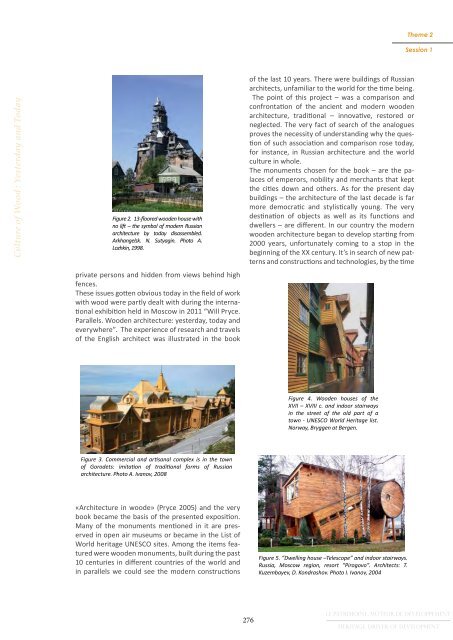PARTIE 2 - Icomos
PARTIE 2 - Icomos
PARTIE 2 - Icomos
Create successful ePaper yourself
Turn your PDF publications into a flip-book with our unique Google optimized e-Paper software.
Theme 2<br />
Session 1<br />
Culture of Wood : Yesterday and Today<br />
Figure 2. 13-floored wooden house with<br />
no lift – the symbol of modern Russian<br />
architecture by today disassembled.<br />
Arkhangelsk. N. Sutyagin. Photo А.<br />
Lozhkin, 1998.<br />
private persons and hidden from views behind high<br />
fences.<br />
These issues gotten obvious today in the field of work<br />
with wood were partly dealt with during the international<br />
exhibition held in Moscow in 2011 “Will Pryce.<br />
Parallels. Wooden architecture: yesterday, today and<br />
everywhere”. The experience of research and travels<br />
of the English architect was illustrated in the book<br />
of the last 10 years. There were buildings of Russian<br />
architects, unfamiliar to the world for the time being.<br />
The point of this project – was a comparison and<br />
confrontation of the ancient and modern wooden<br />
architecture, traditional – innovative, restored or<br />
neglected. The very fact of search of the analogues<br />
proves the necessity of understanding why the question<br />
of such association and comparison rose today,<br />
for instance, in Russian architecture and the world<br />
culture in whole.<br />
The monuments chosen for the book – are the palaces<br />
of emperors, nobility and merchants that kept<br />
the cities down and others. As for the present day<br />
buildings – the architecture of the last decade is far<br />
more democratic and stylistically young. The very<br />
destination of objects as well as its functions and<br />
dwellers – are different. In our country the modern<br />
wooden architecture began to develop starting from<br />
2000 years, unfortunately coming to a stop in the<br />
beginning of the XX century. It’s in search of new patterns<br />
and constructions and technologies, by the time<br />
Figure 4. Wooden houses of the<br />
XVII – XVIII c. and indoor stairways<br />
in the street of the old part of a<br />
town - UNESCO World Heritage list.<br />
Norway, Bryggen at Bergen.<br />
Figure 3. Commercial and artisanal complex is in the town<br />
of Gorodets: imitation of traditional forms of Russian<br />
architecture. Photo А. Ivanov, 2008<br />
«Architecture in woodе» (Pryce 2005) and the very<br />
book became the basis of the presented exposition.<br />
Many of the monuments mentioned in it are preserved<br />
in open air museums or became in the List of<br />
World heritage UNESCO sites. Among the items featured<br />
were wooden monuments, built during the past<br />
10 centuries in different countries of the world and<br />
in parallels we could see the modern constructions<br />
Figure 5. “Dwelling house –Telescope” and indoor stairways.<br />
Russia, Moscow region, resort “Pirogovo”. Architects: T.<br />
Kuzembayev, D. Kondrashov. Photo I. Ivanov, 2004<br />
276<br />
LE PATRIMOINE, MOTEUR DE DÉVELOPPEMENT<br />
HERITAGE, DRIVER OF DEVELOPMENT

















